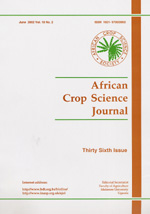
|
African Crop Science Journal
African Crop Science Society
ISSN: 1021-9730
EISSN: 1021-9730
Vol. 28, No. s1, 2020, pp. 117-129
|
 Bioline Code: cs20042
Bioline Code: cs20042
Full paper language: English
Document type: Research Article
Document available free of charge
|
|
|
African Crop Science Journal, Vol. 28, No. s1, 2020, pp. 117-129
| en |
FACTORS INFLUENCING THE CHOICE OF MARKETING STRATEGIES AMONG CASSAVA MICROENTERPRISES IN KENYA
NGENOH, G.C.; KARIUKI, I.M.; GATHUNGU, E.W. & KIPROP, S.K.
Abstract
Cassava ( Manihot esculenta

L.) production and utilisation in Kenya face stiff competition from other
major starchy food crops mainly maize, potatoes and wheat. This is due to the cyanide content in
cassava which is lethal when roots are mishandled, leading to avoidance of the crop by potential
consumers. This has affected the marketing of the crop and its products.The objective of this study
was to analyse factors that influence the choice of marketing strategies among agripreneurs in cassava
microenterprises in Kenya. A studywas conducted in Migori County (Kuria West, Suna East, Suna
West and Uriri Sub-counties) in Kenya, using a semi-structured questionnaire, administered to a
sample of 267 cassava micro enterprises. Results showed that the most used marketing strategies
were pricing, product promotion, value addition and formation of a marketing alliance mostly in their
combination. Multivariate Probit results showed that age, gender, education level, household size,
major occupation (trading), marketing experience, seed money, entrepreneurial training, marketing
information, market distance, group membership, farm gate and open-air marketing outlets significantly
(P<0.05) influenced the choice of marketing strategies among cassava microenterprises. Therefore,
cassava agripreneurs of microenterprises need to combine viable product lines and the marketing
strategies that give maximum performance in order to increase their marketing shares and profits.
Keywords
Agripreneurs; Cyanide; Manihot esculenta; pricing
|
| |
| fr |
NGENOH, G.C.; KARIUKI, I.M.; GATHUNGU, E.W. & KIPROP, S.K.
Résumé
La production etl’utilisation du manioc ( Manihot esculenta

L.) au Kenya sontconfrontées à une
concurrence féroce de la part d’autresprincipales cultures féculentes, principalement le maïs, les pommes
de terre et le blé. Celaestdû à la teneurencyanure du manioc qui estmortellelorsque les racinessont mal
traitées, ce qui conduit à l’évitement de la culture par les consommateurspotentiels. Cela a euune
incidence sur la commercialisation de la culture et de sesproduits. L’objectif de cetteétudeétaitd’analyser
les facteurs qui influencent le choix des stratégies de commercialisation des agripreneurs dans les
microentreprises du manioc au Kenya. Uneétude a étémenéedans le comté de Migori (comtés de Kuria
West, Suna East, Suna West et Uriri) au Kenya à l’aide d’un questionnaire semi-structuré, administré à un échantillon de 267 microentreprises de manioc.Les résultatsontmontré que les stratégies de
marketing les plus utiliséesétaient le prix, la promotion de produits, la valeurajoutée et la formation
d’une alliance de marketing principalementencombinaison. Les résultatsmultivariés de Probit ontmontré
que l’âge, le sexe, le niveau de scolarité, la taille du ménage, la profession principale (négociation),
l’expérience de marketing, l’argent de démarrage, la formation entrepreneuriale, l’information de
marketing, la distance du marché, l’appartenance à un groupe, Les points de vente à la ferme et enplein
air (p<0.05) ontfortementinfluencé le choix des stratégies de commercialisation parmi les
microentreprises de manioc. Par conséquent, les agripreneurs de manioc des microentreprisesdoivent
combiner des gammes de produitsviableset des stratégies de commercialisation qui donnentune
performance maximaleafind’augmenterleurs parts de commercialisation et leursbénéfices.
Mots Clés
Agripreneurs; Cyanure; Manihot esculenta; tarification
|
| |
© Copyright 2020 - African Crop Science Society
|
|
